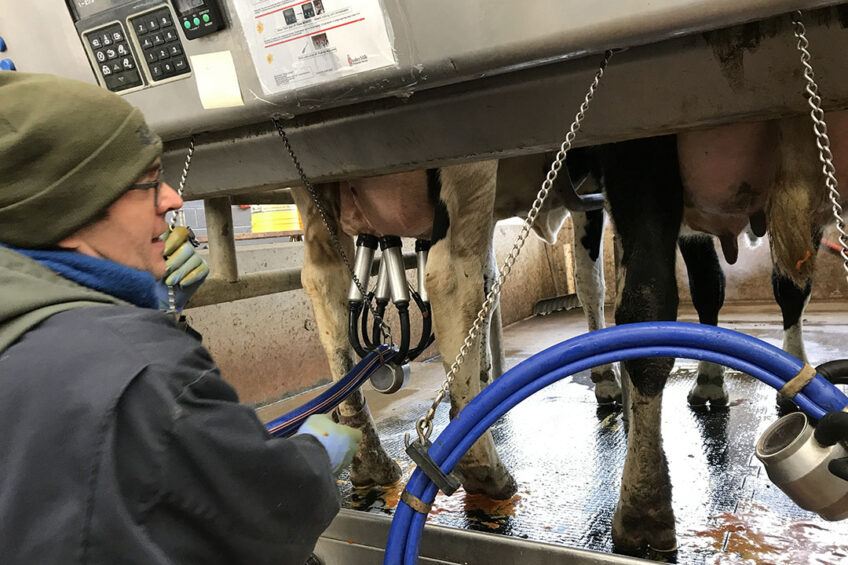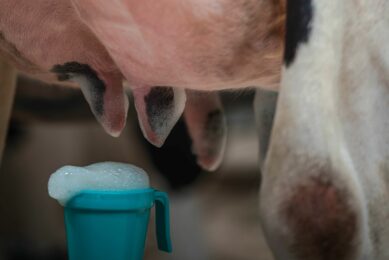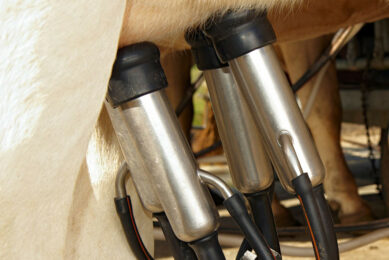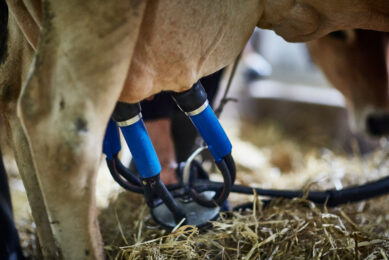Automated stimulation of milk let-down

Results from a study in New York state will hopefully encourage dairy farmers reap the benefits of using automated systems.
If cows are prepared properly before milking (called pre-milking stimulation, or PS), there are many benefits. Among them are rapid milk let-down, faster milk flow rates and milking cows in the minimum amount of time, saving on labour. Most dairy operations still use milk stripping (PS by hand), but various automated systems (APS) have been developed, including ones involving rotating brushes and different forms of pulsation. Automatic teat cleaning devices can also stimulate milk let-down.

Whichever way it’s achieved, stimulation of the teats and udder cause oxytocin to be released from the cow’s brain, which then travels to the udder and further initiates the let-down process. Because stress (release of the stress hormone adrenaline) can counteract oxytocin, both the activities of PS and milking itself should be as stress-free as possible for cows.
Harvesting all milk
That is, if PS is done improperly, not only can this increase milking time but it can also cause milk to be left unharvested in the udder. “In fact, results from a recent Michigan study, together with work from our own group,” says Dr Matthias Wieland, “indicate that between 4 and 6.8 lb (1.9 – 3.2 litres) of milk are left behind.” In addition, says the assistant research professor in the Department of Population Medicine and Diagnostic Sciences at Cornell University College of Veterinary Medicine in New York, improper PS can also aggravate the impact of machine milking on teat tissue, increasing the risk of mastitis.
Because of this, many farmers in the state of New York and beyond are reluctant to switch from milk stripping to any type of automated method. They understand the potential benefits of APS and would like to use it but first need to understand how it can work effectively.
All about MILKING!
To read many more article on daity milking, including an interesting discovery regarding the quality of UHT milk, maximising dairy profit margins, the first hydrogen-powered milk truck for FrieslandCampina, click here.
Wieland explains that through Cornell’s extension service activities, “we have frequently been asked by state dairy producers for help implementing APS in different parlour systems, for example, to facilitate automated pre-dip application to replace human labour. Producers also want to know how to complement manual pre-milking stimulation and improve labour efficiency, and also how to optimise the timing of pre-milking stimulation to meet the physiological requirements of cows with different milking schedules or at different production levels.”

To address these questions and more, Wieland sought funding and his research project began in mid-June 2021. He received funding from the New York Farm Viability Institute, a non-profit organisation which provides grants for research and education that improve the economic viability of New York’s farmers.
“We believe that using APS,” says Wieland, “farmers will be able to achieve let-down efficiently and harvest all the milk available without compromising teat condition or udder health. If APS is adopted on a large scale because of our results, they will see decreased labour costs, increased parlour efficiency and higher overall profitability.”
The project required parlour systems already equipped with APS or those that could have them added in a rapid fashion. In the state of New York as a whole, Wieland estimates that approximately 25% of large dairy operations (over 500 cows) already employ parlour systems with APS features and another 25% can be retrofitted inexpensively.
He adds that although automated milking systems (robots) are on the rise with a projected annual increase of 20 to 30% in the coming years, over 90% of dairy cows in New York state are right now milked with conventional parlour systems.
Differences among APS systems
Before we look at Wieland’s study details, let’s look at how APS can differ between milking system manufacturers. Although there are systems with rotating brushes, Wieland and his colleagues have been investigating systems that use the pulsation system to stimulate cows through the milking liner.
“That is, during the stimulation mode, the pulsation rate in cycles per minute (cpm) is increased from typically 60 cpm to 200-300 cpm,” he explains. “Second, the pulsation ratio is altered as well from typically 65:35 to, for example, 25:75. The latter one results in a short milking phase (during which the milking liner is open) and a long massage phase (during which the milking liner is collapsed and applies gentle pressure).”
He explains that with these changes, little milk is being harvested while the extended massage phase is supposed to trigger pressure-sensitive mechano receptors at the aspect of the teat and elicit the milk-ejection reflex.
Some manufacturers provide APS systems that also facilitate a contemporary decrease of the vacuum level to 20-22 kPa. This vacuum level is sufficient to keep the milking unit attached while harvesting only a little milk.
During milking mode, the pulsation rate and ratio, as well as the vacuum level at the teat are switched to ‘normal’ values (for example pulsation rate 60 cpm, pulsation ratio: 65:35, vacuum 38 kPa at the teat).
“In some systems, the duration of stimulation can be set to the desired value,” Wieland adds. “That is, the exact stimulation duration can be elected. Other manufacturers provide a milk-flow dependant stimulation duration in which the automated stimulation is applied only if the milk flow doesn’t reach a pre-set threshold.”
Study at dairy farm
This 4-month trial, which started in mid-June, is being conducted at a commercial dairy farm milking approximately 1,600 cows and belonging to the client base of Quality Milk Production Services. Wieland and his colleagues have had long-standing research collaborations with this farm and reliable data collection mechanisms are already in place.
At the farm, Holstein cows are housed in sand-bedded free-stall pens and milked 3 times daily with 8-hour milking intervals in a rotary parlour. About 400 cows were randomly allocated into treatment and control groups balanced by parity, stage of lactation, milk production and somatic cell count (SCC).
In the control group, cows are receiving manual PS and the others are getting APS with a pulsation system. Milk yield and milking duration are recorded during each milking session. Composite milk samples are being collected once per month and analysed for fat, protein, lactose, and SCC.
Wieland and his team are also monitoring teat condition (skin colour changes, teat base condition, and teat-end firmness and roughness) weekly, as well as clinical mastitis incidence.
Join 13,000+ subscribers
Subscribe to our newsletter to stay updated about all the need-to-know content in the dairy sector, two times a week.










